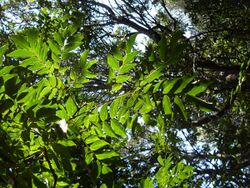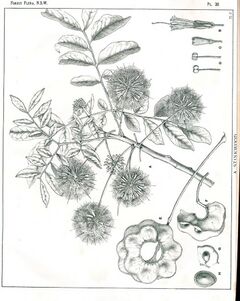Biology:Pararchidendron
| Pararchidendron | |
|---|---|

| |
| Snow-wood at Barrenjoey, Australia | |
| Scientific classification | |
| Kingdom: | Plantae |
| Clade: | Tracheophytes |
| Clade: | Angiosperms |
| Clade: | Eudicots |
| Clade: | Rosids |
| Order: | Fabales |
| Family: | Fabaceae |
| Subfamily: | Caesalpinioideae |
| Clade: | Mimosoid clade |
| Genus: | Pararchidendron I.C.Nielsen (1983) |
| Species: | P. pruinosum
|
| Binomial name | |
| Pararchidendron pruinosum (Benth.) I.C.Nielsen (1983)
| |
| Synonyms[1] | |
| |
Pararchidendron pruinosum is an Australia rainforest tree growing from the Shoalhaven River (34° S) in New South Wales to Herberton (17° S) in north Queensland. It is also native to New Guinea and to Java, Sulawesi, and the Lesser Sunda Islands in Indonesia. Common names include Snow-wood, Tulip Siris and Monkey's Earrings. It is the sole species in genus Pararchidendron.
The habitat of the Snow-wood is tropical, sub-tropical, warm temperate, littoral and riverine rainforest. Like most legume species, it fixes atmospheric nitrogen in the soil via its symbiotic partnership with root bacteria - trading the bacteria starches in exchange for nitrogen. It can be seen growing on sand within earshot of Seven Mile Beach, New South Wales.
Description
Snow-wood is a small to medium-sized tree, reaching 15 metres in height and a 35 cm in trunk diameter. The reddish trunk and lacy pinnate leaves give a pleasing appearance.
The trunk of Pararchidendron pruinosum is cylindrical, and not buttressed at the base. The bark is dark reddish brown patterned with corky pustules.
Leaves
The leaves are alternate and bipinnate. The main leaf stalk has one to three pairs of secondary leaf stalks, opposite or nearly so on the main stalk. Five to eleven leaflets alternatively arranged on the secondary leaf stalks. Leaves entire, lanceolate, four to five cm long, 13 to 20 mm broad. The tip tapers to a point, the leaf base is oblique. Smooth and green both surfaces, slightly paler below. Leaf venation is obvious, with a raised midrib evident on both upper and lower sides.
Flowers and fruit
Flowers fluffy white or greenish, fragrant, though later turning yellow. Flowering period is from October to January.
The fruit pod matures from February to June. Resembling Acacia fruit pods. Very twisted, and flattened. Seeds are black, shiny and mostly flat, oval in shape. Scarification of the seeds is advised to assist germination, which is slow but fairly reliable.
Varieties
Four varieties are accepted:[1]
- Pararchidendron pruinosum var. junghuhnianum (Benth.) I.C.Nielsen
- Pararchidendron pruinosum var. novoguineense I.C.Nielsen
- Pararchidendron pruinosum var. pruinosum
- Pararchidendron pruinosum var. sumbawaense (Kosterm.) I.C.Nielsen
References
- ↑ 1.0 1.1 Pararchidendron pruinosum (Benth.) I.C.Nielsen. Plants of the World Online. Retrieved 13 September 2023.
- Floyd, A.G., Rainforest Trees of Mainland South-eastern Australia, Inkata Press 1989, ISBN:0-909605-57-2
Wikidata ☰ {{{from}}} entry
 |


